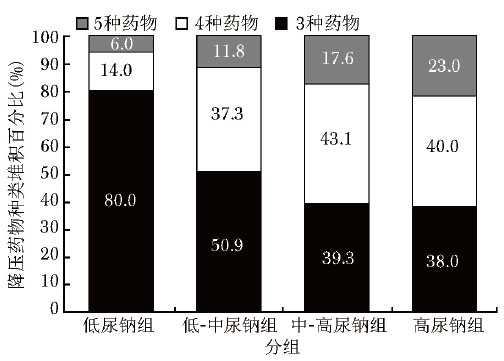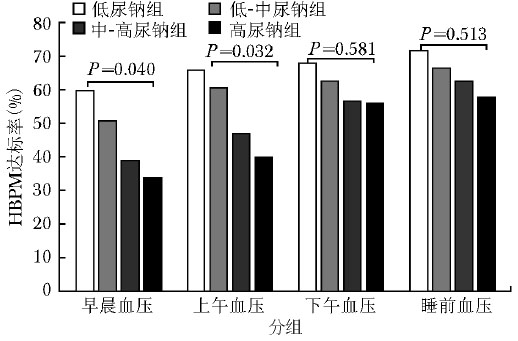Correlation between 24-hour Urinary Sodium Excretion and the Status of Blood Pressure Control in Patients with Resistant Hypertension: A Single-center Cross-sectional Study
-
摘要:目的 分析24 h尿钠排泄与难治性高血压(resistant hypertension,RH)患者诊室血压及家庭自测血压(home blood pressure monitoring,HBPM)达标状态的关系。方法 通过北京协和医院心内科门诊RH数据库,收集2017年10月至2018年3月间在北京协和医院心内科门诊就诊的RH患者临床资料,进行横断面调查。检测患者24 h尿钠,记录患者同期诊室血压、HBPM水平及临床用药情况,以所有患者24 h尿钠水平四分位数为分界点,将研究对象分为低尿钠、低-中尿钠、中-高尿钠及高尿钠4组。采用多因素Logistic回归,分析影响RH血压达标状态的危险因素。结果 共202例RH患者入选本研究,男性107例,女性95例,平均年龄(59.87±16.30)岁。24 h尿钠平均水平为(198.92±96.59)mmol,年轻患者及体质量指数高者尿钠水平更高(P均<0.001)。随尿钠升高,降压药物的服用种类显著增多(P=0.001),早晨及上午的HBPM达标率低(P=0.040, 0.032)。多因素Logistic回归分析显示,24 h尿钠水平与诊室血压(OR=2.356, 95% CI:1.004~5.533, P=0.049),HBPM早晨血压(OR=2.408, 95% CI:1.026~5.650, P=0.030)及HBPM上午血压(OR=2.299, 95% CI:1.031~5.129, P=0.033)达标状态独立相关,而与下午及夜间HBPM血压达标状态无显著相关(P均>0.05)。结论 24 h尿钠是RH患者诊室血压及HBPM早晨及上午血压达标的独立相关因素,限制钠盐摄入对减少RH患者血压波动、促进血压达标有重要作用。Abstract:Objective To study the correlation between 24-hour urinary sodium excretion and the controlling status of office blood pressure (BP) and home blood pressure monitoring (HBPM) in patients with resistant hypertension (RH).Methods A cross-sectional study was performed based on the RH patient database in Peking Union Medical College Hospital. All RH patients treated in the Cardiology Clinic, Peking Union Medical College Hospital from October 2017 to March 2018 were enrolled. Twenty-four-hour urinary sodium excretion (24h-UNa) was examined to estimate daily sodium intake. Office BP, HBPM (4 measurements daily: before medicine in the morning, 10 a.m., 4 p.m., and before sleeping at night, respectively), and the types of antihypertensive drugs were recorded. Based on the quartile method for 24h-UNa excretion, all enrolled patients were stratified into four groups: low 24h-Una, low-mid 24h-UNa, mid-high 24h-UNa, and high 24h-Una groups. Multiple Logistic regression analysis was used to analyze the correlation of independent factors with the rate of BP control.Results Totally 202 subjects were recruited, 107 men, 95 women, aged (59.87±16.30) years, and the 24h-UNa was (198.92±96.59) mmol. Patients with higher urine-sodium excretion were younger and with a higher body mass index (P < 0.001). The number of antihypertensive drugs increased significantly with the increase of urinary sodium level (P=0.001). High urine sodium excretion was associated with the reduced BP control rate for HBPM in the morning and at 10 a.m.. Multivariate Logistic regression analysis showed that 24h-UNa was independently associated with the target achievement of office BP (OR=2.356, 95% CI:1.004-5.533, P=0.049), morning HBPM (OR=2.408, 95% CI:1.026-5.650, P=0.030), and 10 a.m. HBPM (OR=2.299, 95% CI:1.031-5.129, P=0.033), while not with the 4 p.m. and night HBPM.Conclusions 24h-UNa is an independent risk factor for the control rates of office BP and morning HBPM in RH patients. Restriction of sodium salt intake plays an important role in reducing BP fluctuation and improving BP control.
-
粪菌移植(fecal microbiota transplantation, FMT)[1]作为一种将健康供者粪便中的功能菌群分离并移植至患者肠道内,以重建患者体内菌群构成,从而达到疾病治疗目的的新技术,近10年来发展迅速。现代医学应用FMT治疗疾病的历史可追溯至1958年Eiseman等[2]使用健康人粪菌对4例艰难梭菌感染(Clostridium difficile infection,CDI)患者进行灌肠治疗,其中3例患者得到康复。2013年,van Nood等[3]通过随机对照试验(randomized controlled trial,RCT)证明FMT治疗CDI的疗效显著优于万古霉素。同年, 该疗法被写入CDI治疗指南[4]。
虽然FMT作为CDI的重要治疗手段已被美国胃肠病学会写入临床指南,但其在多种疾病(如溃疡性结肠炎[5-7]、肠易激综合征[8]、代谢综合征[9]、黑色素瘤[10]、放射性肠炎[11]等)中的应用尚处于临床试验阶段。然而,一项新兴诊疗技术的临床应用,不仅取决于其自身疗效,还取决于医生和患者的认知和接受程度。美国一项研究表明,仅12%的患者对FMT有所了解,但当病情需要时,在医生的建议下,77%的患者愿意接受该疗法[12],这与Zeitz等[13]的研究结果相似,提示医生对该种治疗手段的认知和接受程度在一定程度上会影响患者的认知和接受程度。
作为医生群体的后备力量,医学生对FMT的认知对未来FMT的临床应用极为重要。此外,医学生身体相对年轻、健康,对医院环境熟悉,可成为粪菌供体的重要来源。2019年,我国一项围绕一年级医学研究生群体的调查研究显示,该群体对FMT的认知度普遍较低,近半数(47.76%)学生对FMT完全不了解[14],但该研究未涉及高年级研究生群体,且未调查医学生群体粪菌捐赠意愿。本研究对不同年级医学生群体关于FMT的认知情况、接受程度及粪菌捐赠意愿展开调查,探讨医学生是否因接受医学教育程度的不同而对FMT存在不同认知,同时为该技术在临床的应用及未来发展提供启发。
1. 对象与方法
1.1 研究对象
本研究为便利抽样调查,以北京协和医学院-清华大学医学部临床医学八年制2014—2021级医学生为调查研究对象。将研究对象分为3组:正在临床进行实习轮转的2014—2016级医学生为临床组,2017—2018级医学生为过渡组,2019—2021级正在生命学院进行生命学科基础课程学习的医学生为基础组。
本研究已通过中国医学科学院北京协和医院伦理审查委员会审批(审批号:S-K1855),并征得所有研究对象知情同意。
1.2 问卷设计及发放
问卷内容包括:(1)研究对象性别、所在年级、家庭居住地、父母职业等基本情况。(2)研究对象对FMT的认知程度,并设置5道知识性选择题:①FMT是否可用于治疗非消化系统疾病?②FMT被美国列入治疗哪种疾病的指南?③世界上第一个应用FMT治疗疾病的人是谁?④FMT中粪便来源必须是亲属吗?⑤FMT操作中将粪菌移植入人体肠道的途径有哪些?每题赋值1分,满分5分。(3)研究对象对FMT应用于患者及自身疾病治疗的态度。(4)研究对象健康自我感知和粪菌捐赠意愿。2021年11月起以电子问卷形式对研究对象展开调查。问卷匿名发放,研究对象自愿、独立完成。
1.3 统计学处理
对全部有效问卷采用SPSS 23.0软件进行统计学分析。计数资料以频数(百分数)表示,组间比较采用卡方检验或Fisher精确概率法;符合正态分布的计量资料(如知识问答题得分)采用均数±标准差表示,组间比较采用独立样本t检验或方差分析。采用Spearman秩相关法对问卷中健康自我感知与粪菌捐赠意愿二分类变量进行相关性分析,以P<0.05为差异具有统计学意义。
2. 结果
2.1 基本情况
本研究共发放问卷210份,回收有效问卷205份,有效回收率为97.6%。所有参与调查的学生中,女生101人,男生104人,83.4%(171/205)的学生家庭居住地为城市,84.9%(174/205)的学生父母双方均非医务人员。
2.2 对FMT的认知程度
85.4 %(175/205)的学生认为自己对FMT仅了解一点或完全不了解,且不同年级学生对FMT的认知程度存在显著性差异(P<0.001)。35.6%(73/205)的医学生对FMT完全不了解,其中以基础组占比最高,与临床组和过渡组相比,差异均具有统计学意义(59.7%比10.3%,P<0.001;59.7%比32.0%,P=0.001)。对于5个知识性问题的回答,临床组和过渡组得分均显著高于基础组(2.85±0.78比1.56±1.06,P<0.001;2.80±0.90比1.56±1.06,P<0.001),但临床组与过渡组比较差异无统计学意义(P=0.954)(表 1)。
表 1 不同年级医学生对FMT的认知度选项 临床组
(n=58)过渡组
(n=75)基础组
(n=72)P值 认知程度[n(%)] <0.001 非常了解(n=2) 1(1.7) 1(1.3) 0(0.0) 基本了解(n=28) 12(20.7) 13(17.3) 3(4.2) 了解一点(n=102) 39(67.2) 37(49.3) 26(36.1) 完全不了解(n=73) 6(10.3) 24(32.0) 43(59.7) 认知问答得分(x±s) 2.85±0.78 2.80±0.90 1.56±1.06 <0.001 FMT: 粪菌移植 2.3 对FMT用于患者疾病治疗的态度
同意将FMT用于患者疾病治疗的学生占77.1%(158/205)。相较于基础组(66.7%),临床组(82.8%)和过渡组(82.7%)的比例均更高。在同意应用FMT对患者进行治疗的158例学生中,将“临床上有成功应用并达到治疗效果的报道”作为同意原因的比例最高(90.5%, 143/158),且在各组中均最高;其次是“移植流程规范,粪菌采集操作自动化程度较高”(70.3%,111/158)。7名(3.4%)不同意FMT用于治疗患者的学生中,所有人均将“循证医学证据尚不足”作为反对的理由,其次是“担心感染未知传染病” (57.1%, 4/7),详见表 2。另有40名(19.5%)学生的态度为“不确定”,提交的陈述性理由包括“采用来源于粪便的治疗让人感觉奇怪”“部分研究表明FMT只有短期疗效,长时间后患者肠道菌群会变回治疗前状态”等。
表 2 不同年级医学生对FMT用于患者疾病治疗的态度及原因分析选项 临床组
(n=58)过渡组
(n=75)基础组
(n=72)1是否同意FMT用于患者疾病治疗? 同意(n=158) 48(82.8) 62(82.7) 48(66.7) 不同意(n=7) 2(3.4) 1(1.3) 4(5.6) 不确定(n=40) 8(13.8) 12(16.0) 20(27.8) 2同意的原因 ①临床上有成功应用并达到治疗效果的报道
(n=143)46(79.3) 58(77.3) 39(54.2) ②移植流程规范,粪菌采集操作自动化程度较高
(n=111)32(55.2) 49(65.3) 30(41.7) ③存在粪菌库(n=79) 24(41.4) 39(52.0) 16(22.2) ④无其他可用手段的无奈之举(n=34) 11(20.0) 13(17.3) 10(13.9) ⑤其他(n=1) 0(0.0) 0(0.0) 1(1.4) 3不同意的原因 ①循证医学证据尚不足
(n=7)2(3.4) 1(1.3) 4(5.6) ②担心感染未知传染病
(n=4)1(1.7) 1(1.3) 2(2.8) ③技术尚不成熟(n=2) 2(3.4) 0(0.0) 0(0.0) ④原料为粪菌,使人感到难为情(n=1) 0(0.0) 0(0.0) 1(1.4) ⑤其他(n=1) 1(1.7) 0(0.0) 0(0.0) FMT: 同表 1 2.4 对FMT用于自身疾病治疗的态度
同意将FMT用于自身疾病治疗的学生占78.0%(160/205),临床组、过渡组、基础组占比分别为77.6%、81.3%、75.0%。10名(4.9%,10/205)学生反对FMT用于自身疾病治疗;35名(17.1%)学生态度为不确定。同意FMT用于自身治疗的160名学生中,选择口服胶囊进行FMT的学生占比最高,达75.0%(120/160),其次是肠镜(67.5%, 108/160),鼻胃管接受程度相对较低(28.1%, 45/160);67.3% (138/205)倾向于听医生推荐选择FMT供体来源(表 3)。
表 3 不同年级医学生对FMT用于自身疾病治疗的态度、途径及粪菌供者来源选项 临床组
(n=58)过渡组
(n=75)基础组
(n=72)1是否同意FMT用于自身疾病治疗? 同意(n=160) 45(77.6) 61(81.3) 54(75.0) 不同意(n=10) 3(5.2) 4(5.3) 3(4.2) 不确定(n=35) 10(17.2) 10(13.3) 15(20.8) 2若同意FMT,将会选择哪些途径? 口服胶囊(n=120) 34(58.6) 49(65.3) 37(51.4) 肠镜(n=108) 28(48.3) 51(68.0) 29(40.3) 鼻胃管(n=45) 8(13.8) 22(29.3) 15(20.8) 不知道(n=11) 1(1.7) 4(5.3) 6(8.3) 3若同意FMT,将如何选择供体来源? 医师推荐(n=138) 37(63.8) 56(74.7) 45(62.5) 粪菌库(n=58) 16(27.6) 24(32.0) 18(25.0) 亲属(n=38) 13(22.4) 11(14.7) 14(19.4) 朋友(n=24) 4(6.9) 11(14.7) 9(12.5) FMT: 同表 1 2.5 健康自我感知与粪菌捐赠意愿
自我感知健康的学生占比67.3%(138/205),愿意捐赠自己粪菌以供患者使用的医学生占比83.7%(169/202)(表 4)。自我感知健康情况与捐赠意愿存在显著正相关(r=0.164,P=0.018)。在不愿意捐赠粪菌的学生中,60.0%(3/5)选择的理由为“对采集粪便样本感到难为情、肮脏、不方便”,其次是“对FMT不感兴趣”(40.0%,2/5)和“FMT循证医学证据尚不足” (20.0%,1/5)。
表 4 不同年级医学生健康自我感知情况及粪菌捐赠意愿选项 临床组
(n=58)过渡组
(n=75)基础组
(n=72)1健康自我感知 健康(n=138) 46(79.3) 43(57.3) 49(68.1) 不健康(n=27) 4(6.9) 15(20.0) 8(11.1) 不确定(n=40) 8(13.8) 17(22.7) 15(20.8) 2是否愿意捐赠粪菌? 愿意(n=169) 49(84.5) 58(77.3) 62(86.1) 不愿意(n=5) 1(1.7) 3(4.0) 1(1.4) 无所谓(n=31) 8(13.8) 14(18.7) 9(12.5) 3. 讨论
本研究发现,大多数(85.4%)医学生认为自己对FMT仅了解一点或完全不了解,而关于FMT的5道知识性问答题的得分也印证了这一自评结果。本研究中,完全不了解FMT的学生占比为35.6%(73/205),该结果略优于Wu等[14]在中国低年级医学研究生群体(47.8%)中的调查结果,但显著优于Orduna等[15]在墨西哥社交网络人群(72.0%)中的调查结果,提示医学生对FMT的了解程度高于普通人群。但本研究完全不了解FMT的医学生中,58.9%(43/73)为低年级学生(基础组),高年级学生(临床组)仅为8.2%(6/73),说明随着接受医学教育年限的增加,医学生对临床新诊疗技术的了解程度更加深入。
同意FMT用于患者疾病治疗的学生占比为77.1%(158/205),同意用于自身疾病治疗的学生占比78.0%(160/205),愿意为患者捐赠自身粪菌者占比83.7%(169/205),提示相较将FMT操作直接应用于患者治疗,医学生更易于接受自身作为一种治疗方案的探索,包括捐赠自身粪菌及以自身为研究对象的探索。而其较高的捐赠意向,也为FMT相关临床试验在医学院校的开展提供了可能。澳大利亚一项评估消化科医生对FMT看法的问卷调查显示,90.0%的消化科医生推荐CDI患者接受FMT,本研究中低年级医学生(基础组)同意FMT用于患者疾病治疗的比例为66.7%,但中高年级医学生(过渡组和临床组)同意FMT用于患者疾病治疗的比例均超过80%[7],提示随着临床知识储备程度的加深,医学生对FMT的接受程度呈进一步增长趋势,更接近于临床医生。
有趣的是,基础组学生虽然同意将FMT用于患者及自身疾病治疗比例均最低(66.7%和75.0%),但相较于用于患者疾病治疗,同意将FMT应用于自身疾病治疗的人数有较大幅度提高,笔者推测,尚未实际接触临床的低年级医学生在面临一项并不十分了解的新技术时,可能因其自身职业属性的特点,作出的决定相对更为保守,但医者的职业奉献精神又决定了他们更愿意通过自身对该技术进行验证后再考虑是否应用于患者。其真实原因仍待后续深入访谈后加以探析。
同意FMT用于患者疾病治疗的158名学生中,将“临床上有成功应用并达到治疗效果”作为同意原因的比例在各组中均最高(临床组、过渡组、基础组中各自所占比例分别为79.3%、77.3%、54.2%),在7名不同意FMT用于患者疾病治疗的学生中,所有人均将“循证医学证据不足”作为反对的理由,提示当前医学生群体亦十分重视循证医学证据。若在临床实现FMT的应用及推广,以RCT为代表的临床研究是必要且必需的。我国另一项针对844名临床医生群体关于FMT应用的问卷调查结果显示,临床医生最关心的问题是患者对FMT的接受度(79.2%),反对的理由包括缺乏标准化指南(56.9%)、涉及伦理问题(46.5%)等[16]。本研究中反对/不确定的理由还包括“担心染上其他未知传染性疾病”“采用来源于粪便的治疗让人感觉奇怪”“部分研究表明FMT只有短期疗效,长时间后患者肠道菌群会变回治疗前状态”等,这些顾虑为该技术的未来研究进一步指明了方向,并对临床宣教侧重点具有提示意义。
同意将FMT应用于自身疾病治疗的学生中,选择口服胶囊途径的学生比例最高,达75.0% (120/160),鼻胃管是最不受欢迎的方式(28.1%, 45/160),这与Wu等[14]和Park等[17]在患者群体中的调查结果相一致。提示将胶囊作为FMT菌群载体或为该技术改进的一个方向。67.3% (138/205)倾向于听医生推荐来选择FMT的供体来源,低于Park等[17]在美国的一项研究结果(94.0%), 或许与本研究所涉群体即未来有可能成为医生的医学生群体有关,其对FMT供体来源有更多自己的想法与思考。
4. 小结
一项新型临床研究的进行一定程度上取决于该研究在青年医学人群中的认知水平及接受程度,本研究调查表明,多数医学生愿意接受FMT作为治疗时一种探索性的尝试,从而有助于推动FMT相关临床研究在国内的开展。医学生作为具备一定专业知识储备且处于一生中知识更新水平相对较为迅捷的一类人群,未来应重视在该群体中的相关推广工作,增进其对FMT的认知及接受程度,同时能够为新技术的发展与改进带来更多思考和建议。
利益冲突 无 -
表 1 202例难治性高血压患者一般临床资料
人群特征 总体(n=202) 低尿钠组(n=50) 低-中尿钠组(n=51) 中-高尿钠组(n=51) 高尿钠组(n=50) P值 年龄(x±s,岁) 59.87±16.30 66.04±13.32 63.70±14.93 55.74±14.80 49.00±16.30 <0.01 男性[n(%)] 107(53.0) 21(42.0) 24(47.1) 30(58.8) 32(64.0) 0.059 BMI(x±s,kg/m2) 25.03±4.26 25.62±4.12 25.67±2.68 27.69±3.00 30.34±5.97 <0.01 腰围(x±s,cm) 94.68±11.00 89.00±8.64 92.04±7.46 97.44±8.56 102.19±11.57 <0.01 吸烟[n(%)] 24(11.9) 3(6.0) 5(9.8) 6(11.8) 10(20.0) 0.075 饮酒[n(%)] 27(13.4) 4(8.0) 8(15.7) 5(9.8) 10(20.0) 0.135 卒中[n(%)] 19(9.4) 3(6.0) 9(17.6) 4(7.8) 3(6.0) 0.070 糖尿病[n(%)] 62(30.7) 8(16.0) 23(45.1) 15(29.4) 16(32.0) <0.01 空腹血糖(x±s,mmol/L) 6.96±2.54 6.82±3.42 6.37±1.01 7.04±3.24 6.69±1.84 0.828 糖化血红蛋白(x±s,%) 6.50±1.31 6.06±1.91 6.19±0.73 7.06±1.92 5.79±1.73 0.145 总胆固醇(x±s,mmol/L) 4.37±1.01 4.22±1.29 4.16±0.78 4.35±1.08 4.62±0.89 0.424 LDL-C(x±s,mmol/L) 2.44±0.88 2.21±1.05 2.41±0.91 2.37±0.88 2.59±0.71 0.527 eGFR[x±s,ml/(min·1.73 m2)] 80.69±23.30 75.68±24.76 75.00±25.05 83.71±19.52 87.18±25.69 0.183 平均用药数量(x±s) 3.62±0.72 3.26±0.56 3.61±0.70 3.78±0.73 3.84±0.77 <0.01 24 h尿钠(x±s,mmol) 198.9±96.6 92.34±22.79 157.15±16.39 212.32±15.16 333.91±72.61 <0.01 P值为4组间整体比较的统计学分析结果;BMI:体质量指数; LDL-C:低密度脂蛋白胆固醇;eGFR:估计肾小球滤过率 表 2 影响难治性高血压患者诊室及家庭自测血压达标状态的多因素Logistic回归分析
影响因素 诊室血压达标 家庭自测血压达标 OR(95% CI) P值 早晨 上午 下午 睡前 OR(95% CI) P值 OR(95% CI) P值 OR(95% CI) P值 OR(95% CI) P值 BMI 2.473(1.020~5.996) 0.045 1.040(0.460~2.334) 0.925 0.876(0.307~2.498) 0.805 1.174(0.415~3.319) 0.762 1.590(0.548~4.616) 0.394 eGFR 1.560(0.805~3.020) 0.187 0.217(0.054~0.880) 0.032 0.248(0.055~1.113) 0.069 1.614(0.638~4.083) 0.321 1.841(0.736~4.603) 0.192 24 h尿钠 2.356(1.004~5.533) 0.049 2.408(1.026~5.650) 0.030 2.299(1.031~5.129) 0.033 1.485(0.471~4.681) 0.500 1.610(0.427~6.069) 0.481 24 h尿钾 0.996(0.589~1.686) 0.989 1.231(0.783~1.936) 0.368 1.430(0.785~2.605) 0.243 0.908(0.491~1.679) 0.758 0.697(0.210~2.315) 0.556 应用螺内酯 0.447(0.144~1.384) 0.163 0.991(0.316~3.113) 0.988 0.787(0.231~2.687) 0.703 0.489(0.130~1.847) 0.292 0.285(0.066~1.239) 0.094 ≥4种抗高血压药物 0.327(0.110~0.972) 0.044 0.415(0.121~1.422) 0.162 0.873(0.268~2.844) 0.822 0.661(0.175~2.489) 0.540 0.211(0.047~0.943) 0.042 诊室血压以<140/90 mm Hg为达标,家庭自测血压以<135/85 mm Hg为达标; BMI、eGFR:同表 1 -
[1] Mozaffarian D, Fahimi S, Singh GM, et al. Global sodium consumption and death from cardiovascular causes[J]. N Engl J Med, 2014, 371: 624-634. DOI: 10.1056/NEJMoa1304127
[2] Juraschek SP, Miller ER Ⅲ, Weaver CM, et al. Effects of Sodium Reduction and the DASH Diet in Relation to Baseline Blood Pressure[J]. J Am Coll Cardiol, 2017, 70: 2841-2848. DOI: 10.1016/j.jacc.2017.10.011
[3] 中华医学会心血管病学分会高血压学组.限盐管理控制高血压中国专家指导意见[J].中华高血压杂志, 2015, 23: 1028-1034. http://www.wanfangdata.com.cn/details/detail.do?_type=perio&id=gxyzz201511013 [4] 孙宁玲, 霍勇, 王继光, 等.难治性高血压诊断治疗中国专家共识[J].中华高血压杂志, 2013, 21: 321-326. http://www.wanfangdata.com.cn/details/detail.do?_type=perio&id=gxyzz201304007 [5] 孙宁玲, 牟建军, 李玉明.高血压患者盐摄入量评估和血压管理临床流程专家建议书[J].中华高血压杂志, 2016, 24: 727-728. http://www.wanfangdata.com.cn/details/detail.do?_type=perio&id=gxyzz201608008 [6] Stergiou GS, Siontis KC, Ioannidis JP. Home blood pressure as a cardiovascular outcome predictor: it's time to take this method seriously[J]. Hypertension, 2010, 55: 1301-1303. DOI: 10.1161/HYPERTENSIONAHA.110.150771
[7] Dolan E, Stanton A, Thijs L, et al. Superiority of ambulatory over clinic blood pressure measurement in predicting mortality: the Dublin outcome study[J]. Hypertension, 2005, 46: 156-161. DOI: 10.1161/01.HYP.0000170138.56903.7a
[8] Levey AS, Stevens LA, Schmid CH, et al. A new equation to estimate glomerular filtration rate[J]. Ann Intern Med, 2009, 150: 604-612. DOI: 10.7326/0003-4819-150-9-200905050-00006
[9] 中国高血压防治指南修订委员会.中国高血压防治指南2010[J].中华高血压杂志, 2011, 19: 701-743. http://www.wanfangdata.com.cn/details/detail.do?_type=perio&id=gxyzz201108001 [10] 孙宁玲.高盐-高血压的科学之声[J].中华高血压杂志, 2017, 25: 519-524. [11] Rust P, Ekmekcioglu C. Impact of Salt Intake on the Pathogenesis and Treatment of Hypertension[J]. Adv Exp Med Biol, 2017, 956: 61-84.
[12] Mente A, O'Donnell MJ, Rangarajan S, et al. Association of urinary sodium and potassium excretion with blood pressure[J]. N Engl J Med, 2014, 371: 601-611. DOI: 10.1056/NEJMoa1311989
[13] Mente A, O'Donnell M, Rangarajan S, et al. Associations of urinary sodium excretion with cardiovascular events in individuals with and without hypertension: a pooled analysis of data from four studies[J]. Lancet, 2016, 388: 465-475. DOI: 10.1016/S0140-6736(16)30467-6
[14] Sica DA, Carter B, Cushman W, et al. Thiazide and loop diuretics[J]. J Clin Hypertens, 2011, 13: 639-643. DOI: 10.1111/j.1751-7176.2011.00512.x
[15] Group ICR. Intersalt: an international study of electrolyte excretion and blood pressure. Results for 24 hour urinary sodium and potassium excretion[J]. BMJ, 1988, 297: 319-328. DOI: 10.1136/bmj.297.6644.319
[16] Grassi G, Dell'Oro R, Seravalle G, et al. Short-and long-term neuroadrenergic effects of moderate dietary sodium restriction in essential hypertension[J]. Circulation, 2002, 106: 1957-1961. DOI: 10.1161/01.CIR.0000033519.45615.C7
[17] DiBona GF. Neural control of the kidney: past, present, and future[J]. Hypertension, 2003, 41: 621-624. DOI: 10.1161/01.HYP.0000047205.52509.8A
[18] Campese VM, Romoff MS, Levitan D, et al. Abnormal relationship between sodium intake and sympathetic nervous system activity in salt-sensitive patients with essential hypertension[J]. Kidney Int, 1982, 21: 371-378. DOI: 10.1038/ki.1982.32
[19] Linde CI, Karashima E, Raina H, et al. Increased arterial smooth muscle Ca2+ signaling, vasoconstriction, and myogenic reactivity in Milan hypertensive rats[J]. Am J Physiol Heart Circ Physiol, 2012, 302: H611-H620. DOI: 10.1152/ajpheart.00950.2011
[20] 李师承, 陈连凤, 冯淑怡, 等.高盐饮食对去甲肾上腺素诱导的Dahl盐敏感大鼠肠系膜动脉收缩反应的影响[J].中国心血管杂志, 2018, 23: 264-269. DOI: 10.3969/j.issn.1007-5410.2018.03.019 [21] Toda N, Arakawa K. Salt-induced hemodynamic regulation mediated by nitric oxide[J]. J Hypertens, 2011, 29: 415-424. DOI: 10.1097/HJH.0b013e328341d19e
-
期刊类型引用(1)
1. 吴沈雅,戴韻. 达芬奇机器人辅助下腹腔镜肾部分切除术后出血的观察与护理. 加速康复外科杂志. 2022(04): 184-187 .  百度学术
百度学术
其他类型引用(0)

 作者投稿
作者投稿 专家审稿
专家审稿 编辑办公
编辑办公 邮件订阅
邮件订阅 RSS
RSS

 下载:
下载:


